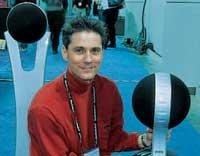Audio

Fortunately, the saying "What happens in Vegas, stays in Vegas" doesn't apply to CES. The technology introduced there quickly spreads to the rest of the world. This year, audio companies were especially anxious to have the show's magic rub off on their wares. After years of falling sales for staple items like receivers and traditional speaker systems, they were looking for the audio equivalent of a sure bet.
One move that's paid off is the introduction of lifestyle-oriented, décor-friendly speakers. For instance, Snell teamed with the designer behind Apple's original mouse and Amtrak's Acela trains to craft its new Series 7 speakers (due by April, starting at $1,200 a pair). Artistic Audio has the spherical Hemisphere and Möbius speakers (shown above, respectively $600 and $1,200 each), while B&W used a bubble's form as inspiration for its PV1 Pressure Vessel subwoofer ($1,500)
KEF's KHT 9000 ($900 each) features an elegant, rounded silver cabinet housing a 6 1/2-inch Uni-Q driver and two 6 1/2-inch woofers. Place it on its wall bracket and a filter engages to compensate for surface reflections. Meanwhile, S3i Sound showed the plasma-friendliest design yet. Using technology designed for U.S. Navy sonar systems, its "exciter" ($450 a channel) can be attached to a solid, flat surface like sheetrock, wood, or glass to turn it into a speaker. The sound isn't home theater quality, but good enough for background music.
Matching electronics with these sleek TVs and speakers can be a challenge, but Yamaha's RX-SL100 receiver (due in April at $499) and DV-SL100 DVD player (April, $199), with their striking super-thin silver chassis, should make the job easier. Panasonic's SA-XR70 receiver ($399, due in August) features a forward-looking connection - an HDMI (High-Definition Multimedia Interface) digital jack that supports high-definition images up to 1080p (progressive-scan) and multichannel audio formats like DVD-Audio and SACD.
NHT unveiled a subwoofer/satellite system that incorporates digital signal processing (DSP) by Australian company DEQX to minimize a room's impact on sound. You can set the optimal frequency response based on a speaker's position, while the DSP software lets you compensate for the room's acoustics. And the sub receives its signal via a Wi-Fi wireless connection. A three-piece stereo package is promised for summer at around $4,800.
Multichannel audio has been pretty much a housebound phenomena - until now. Satellite-radio provider Sirius hosted performances that were encoded in real time with multichannel "logic steering" instructions using Dolby Pro Logic II and then broadcast. Anyone whose Sirius-equipped car or home receiver has DPL II could hear the performance in surround.
Two CES events mapped out audio's future. At Sony's press conference, president Hideki "Dick" Komiyama stated that more digital music is heard on portable players than on any other kind of gear. And at his keynote address, Microsoft chairman Bill Gates proclaimed that CDs, DVDs, and videogames will soon disappear, replaced by take-anywhere data files. You'll no longer be chained to a single computer or entertainment system - everything will be available everywhere, anytime. But how good will it sound . . . ?
- Log in or register to post comments



































































